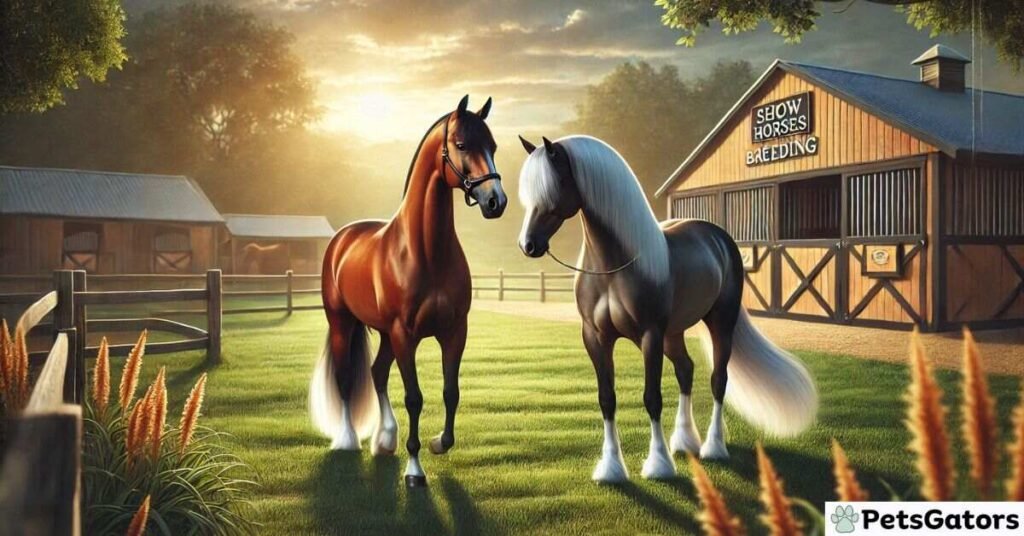Introduction
Breeding shows horses are really an art and science blended together with adequate knowledge of genetics, good planning, and, most of all, a passion for excellence. Moreover, it is about progressive generations of champions with excellent athleticism, temperament, and conformation.
It is not just about matching a particular stallion and mare. Whether the goal is to create a graceful dressage horse, a powerful show jumper with a lot of zeal, or something else, the actual process involves so much more than pure chance. Every part of the journey, from choosing great bloodlines to the very best expert care of the foal after birth, is vital in shaping an ultimate horse that can shine in the arena of competition.
How do you breed showhorses?
Breeding show horses is an art that combines science, tradition, and innovation. Here’s a step-by-step guide with a unique perspective that blends classic methods with modern techniques:
1. Envision the Ideal Show Horse (The Pharaoh’s Blueprint)
Just like the Pharaohs envisioned perfect pyramids, create a clear vision of your ideal horse. Consider traits like agility, temperament, and aesthetics suited for the discipline. Sketch a mental “blueprint” combining genetic potential with personal goals, ensuring you have a direction before breeding begins.
2. Study Bloodlines Like a Historian
Delve into pedigrees as if uncovering ancient scrolls. Look for sires and dams with exceptional show records and desired traits. Focus on “legacy traits,” such as a proven stride or competitive endurance, passed down through generations.
3. Perform a Ritual Health Check
Treat your mare and stallion like royalty; schedule a comprehensive veterinary exam to ensure they’re fit for breeding. Screen for hereditary issues, much like ensuring no cracks exist in a Pharaoh’s pyramid.
4. Optimize Fertility Cycles with Precision
Harness modern tools like ultrasound to track the mare’s estrous cycle with the precision of aligning stars. Timing breeding during peak fertility ensures the highest chance of success.
5. Engage in Genetic Alchemy
Consider advanced methods like gene testing to predict coat colors, conformation, and resistance to diseases. Mix the genetic “elements” of the stallion and mare to craft a foal with a competitive edge, akin to ancient alchemists creating gold.
6. Create a Sacred Space for Breeding
Ensure the environment for natural breeding or artificial insemination is serene and secure, minimizing stress. If using AI, think of it as summoning the best qualities of the stallion remotely.
7. Honor the Mare During Pregnancy (The Queen’s Care)
Provide premium nutrition, supplements, and regular care, much like offering tributes to a queen. Enrich her environment with comfort and stimulation to ensure a stress-free pregnancy.
8. Birth the Foal with a Ceremony
Be present during foaling, ensuring safety and reverence for the moment. Treat the foal like the Pharaoh’s heir—monitor vital signs, provide gentle care, and document the birth.
Read Previous – Are Australian saddles less likely to hurt horses back
What Are the Common Challenges in Breeding Show Horses?
Breeding show horses is a rewarding endeavor, but it comes with its fair share of challenges. Selecting the best pair, seeing the health of a foal, and its future potential are among the many barriers breeders face that require proper planning and expert advice.
Below are some of the breeding challenges within the breeding show horses with their solutions.
1. Selecting Compatible Stallions and Mares
There are many challenges faced when looking for the best stallion-mare combination that has both genetic and physical compatibility. An unsuccessful pairing will give a poorly conformed foal and unwanted characteristics or health problems. Evaluating pedigrees and conformations and comparing temperaments takes time and probably consulting with veterinarians and equine geneticists.
Solution
Investigate bloodlines thoroughly, and concentrate on complementary characteristics. Deflect inherited health issues through genetic testing and consult with industry experts to ensure compatibility.
2. Managing Fertility Issues
Indeed, all horses do not have brown best fertility, and some might not conceive or carry out a pregnancy. Age, health problems, and stress affect fertility in both mares and stallions. It can delay breeding schedules in time and cost money.
Solution
Complete veterinary examinations on both stallion and mare to identify and rectify any fertility issues. Nutrition, stress reduction, and advanced reproductive techniques like artificial insemination (AI) or embryo transfer may enhance success rates.
3. High Costs of Breeding
Breeding show horses can be very expensive, including veterinary charges, stallion stud fees, genetic testing, prenatal care for the mare, and training for the foal. Complications that may arise include those that are related to breeding and foaling, and these could give rise to other unexpected expenses.
Solution
Establish a very extensive financial allocation to cover all possible expenses, which would include possibly obtaining equine insurance for the major costs that might be accrued for medical emergencies or fertility treatments.
4. Foaling Complications
The time of foaling is an important event for the mare and her foal. Complications during this process may include dystocia (difficult birth), premature birth, or stillbirth, all of which endanger the lives of mare and foal. It is therefore important to be prepared and equipped to deal with emergencies during this all-important time for the mare and foal.
Solution
During the final course of pregnancy, a careful watch on the mare is recommended and the area should be prepared as a clean and secure foaling area. Keep a veterinarian on standby to make sure any complications are addressed quickly.
5. Ensuring Foal Health
It is always challenging to guarantee the health of foals even after successful births. Neonatal foals are susceptible to bacteria-induced infections, developmental disorders, as well as other injuries. Having proper nutrition and early care is mandatory to set the pace for the foal for the rest of its life.
Solution
Neonatal care should be included and the foal must receive colostrum in the first few hours of life. Ensure a veterinary checkup within 24 hours, and maintain a good, clean, and safe environment to avoid infection.
FAQs
Are there specific breeding techniques that improve the chances of a successful pregnancy?
Yes, techniques like tracking the mare’s estrous cycle with ultrasound, providing optimal nutrition, and using artificial insemination or embryo transfer can significantly improve the chances of a successful pregnancy.
Is breeding show horses a profitable venture?
Breeding show horses can be profitable but is not guaranteed. It requires significant investment in terms of time, money, and resources. Successful breeding depends on producing high-quality horses that excel in competitions.
Is early training important for foals born from show-horse breeding?
Yes, early training is important. Foals need proper socialization, handling, and movement training to develop into competitive show horses. Consistent and gentle training helps build confidence and discipline.
Conclusion
It is an extremely nitty and valuable procedure of breeding show horses as it requires in-depth knowledge of horse genetics, conformation, and training. This is paired with good selective breeding of stallions and mares, providing good care during the pregnancy, and bringing it into good training, which will help in producing high-potential show horses ready for competition.
Ethical breeding, continuous monitoring of health, and a total commitment to animal well-being are inherent prerequisites of successful breeding. Most significantly, breeders can make a path to the future of the sport with some patience and expertise with sound, talented, and strong show horses.
Stay connected and updated with – PetsGators.com!







